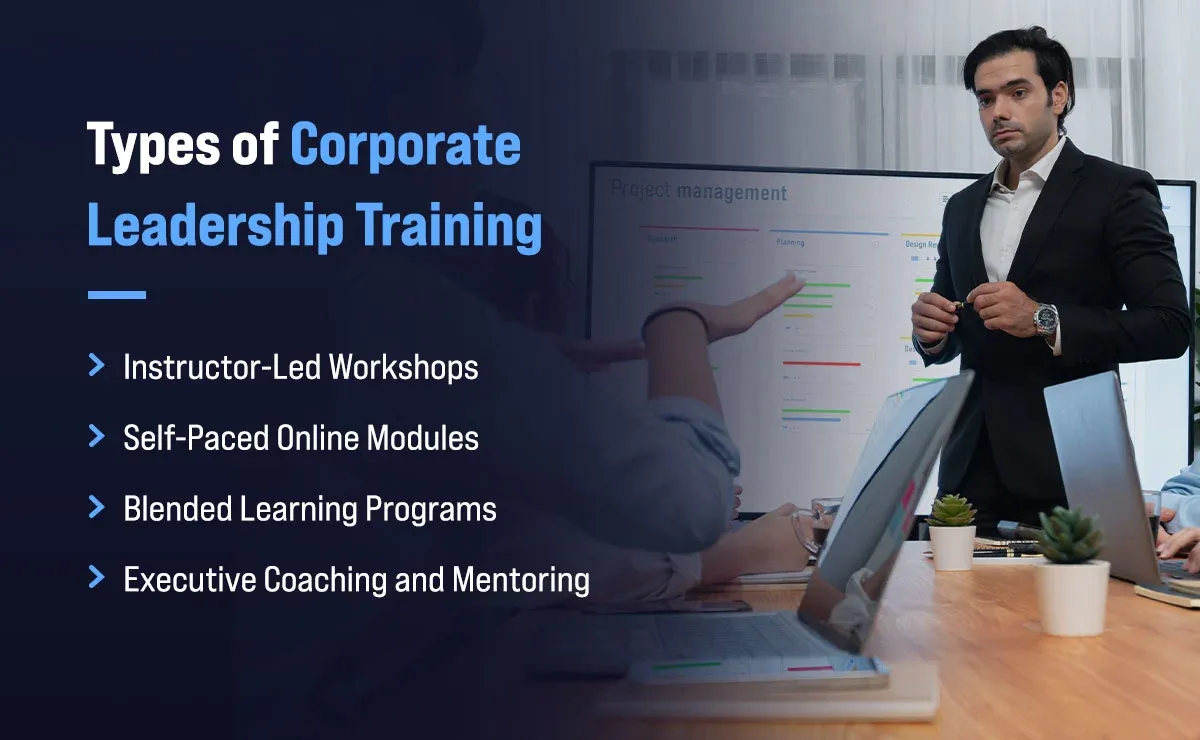What is Corporate Leadership Training?

Effective leadership serves as the foundation for all facets of an organization’s achievements. In a business landscape defined by constant change and increasing complexity, cultivating skilled leaders is not merely an advantage but a necessity for overcoming obstacles and reaching strategic objectives.
Corporate leadership training develops the crucial competencies that today’s leaders require, like deep self‑insight, a clear strategic vision, exceptional communication skills, emotional resilience, and the capacity to empower others. These programs prioritize real-world implementation over theoretical concepts, turning potential into tangible results.
Studies reveal that companies investing in leadership training early are over four times more likely to excel beyond their rivals. This article equips you with the knowledge and tools to assemble and nurture a high‑performing leadership team.
Understanding Corporate Leadership Training
Corporate leadership training is a comprehensive and strategically designed development initiative that equips current and emerging leaders with the skills, knowledge, and mindset required to lead with impact. Far beyond one-time seminars or generic management workshops, these programs offer an in-depth, practical approach to building leadership excellence across all levels of an organization.
Effective leadership training focuses on the following key areas:
- Self-Awareness and Authenticity: Through assessments such as 360-degree feedback, personality profiling, and reflective practices, participants gain a deeper understanding of their strengths, limitations, and leadership styles. This heightened self-awareness promotes authenticity, which is an essential quality for building trust and inspiring genuine commitment among team members.
- Strategic Vision and Planning: Leadership training helps participants develop the ability to craft and articulate a clear, forward-thinking vision. Leaders learn how to translate broad strategic goals into actionable initiatives, aligning team efforts and resources with long-term organizational priorities.
- Communication and Influence: Development programs refine a leader’s capacity to convey messages with precision, intent, and emotional intelligence. Whether through storytelling, active listening, or stakeholder engagement, leaders learn to build alignment, motivate teams, and foster collaboration across diverse audiences.
- Coaching and Constructive Feedback: A critical component of leadership is the ability to support others’ development. Leaders are taught how to provide feedback that is both constructive and motivating, ask insightful questions, and guide team members in creating their own growth paths. Practical exercises and role-plays reinforce these coaching capabilities in real-world scenarios.
- Resilience and Leading Through: Leadership training develops the ability to remain calm under pressure, manage stress effectively, and guide teams through uncertainty. It also equips leaders to frame change positively and mobilize others around new initiatives.
- Delegation and Empowerment: Effective leaders understand how to delegate with intention. Training teaches leaders to discern which tasks need supervision, and which can be confidently delegated. Leaders learn how to empower their teams, promote accountability, and create opportunities for growth, ultimately multiplying their impact.
When delivered as a cohesive and continuous learning journey, corporate leadership training enables individuals to unlock their full potential and prepares them to take on increasing responsibility with confidence.
Types of Corporate Leadership Training
Below are the principal categories of corporate leadership training, each designed to address different developmental needs and learning preferences. By selecting and combining these approaches, organizations can craft programs that build confident, capable leaders at every level.

- Instructor‑Led Workshops: Traditional workshops remain a cornerstone of leadership development. Skilled facilitators guide participants through interactive exercises in strategic vision building, communication, team dynamics, and decision-making. Real‑time discussion and peer exchange deepen learning, while group activities reinforce collaboration and problem solving.
- Self‑Paced Online Modules: Digital courses enable future leaders to learn flexibly, covering areas like emotional intelligence, dispute resolution, productivity, and principled leadership. Interactive quizzes, video case studies, and downloadable templates ensure that key concepts are absorbed and readily applied on the job.
- Blended Learning Programs: Blended learning combines digital content with live sessions to offer flexibility without losing engagement. Learners start by completing foundational online modules on key leadership theories, then come together for subsequent workshops or peer coaching circles where they apply new skills, exchange insights, and receive feedback from instructors and peers.
- Executive Coaching and Mentoring: One‑on‑one coaching pairs emerging or senior leaders with experienced executives or certified coaches. Through confidential conversations, leaders explore personal strengths and blind spots, co‑create development plans, and receive tailored guidance on real‑world challenges. Mentoring relationships often extend beyond formal programs, building lasting support networks.
- Specialized Workshops: These are targeted short courses focusing on emerging leadership competencies such as digital transformation, diversity and inclusion, sustainability leadership, and crisis resilience. These standalone modules enable organizations to adapt quickly to evolving business priorities while equipping leaders with the most current expertise.
By blending these training types, companies create robust leadership development journeys. This multifaceted approach ensures that participants gain theoretical grounding, hands‑on practice, and ongoing support, transforming potential into sustained performance.
What is Corporate Leadership Training Used For?
Within an organization, corporate leadership training fulfills several strategic objectives:
- Engagement and Retention of Talent: Businesses show that they value their employees' professional development by making investments in their training. This commitment reduces turnover and the associated costs of hiring and onboarding new employees while boosting job satisfaction and loyalty.
- Succession Planning: High-potential individuals can be identified and prepared to take on important roles with the help of structured leadership programs. Early training of these future leaders reduces business continuity disruption and guarantees a seamless transition when important roles become available.
- Performance Improvement: Training gives leaders proven strategies for motivating their teams, communicating, and making decisions. Teams led by capable leaders consequently become more inventive, productive, and in line with company objectives.
- Shaping Culture: Leaders establish the standard of conduct and mindsets in the workplace. They receive training on how to create inclusive settings, set an example of moral behavior, and create a supportive atmosphere that promotes cooperation, innovation, and responsibility.
- Change and Agility: In unpredictable markets, businesses require leaders capable of swift adaptation. Leadership training builds the resilience and strategic thinking necessary to guide change initiatives, navigate uncertainty, and seize new opportunities.
- Increasing Competitive Advantage: Strong leadership pipelines put businesses in a better position to innovate, adapt to changes in the market, and sustain long-term growth. Well-trained leaders maintain the company's standing in the marketplace, drive their strategic vision, and lead operational execution.
In summary, corporate leadership training empowers organizations to achieve their strategic objectives by boosting performance, strengthening succession planning, improving retention, cultivating a positive culture, and enhancing overall agility.
Corporate Leadership Training Topics
Effective corporate leaders possess a toolkit of relevant topics that enable them to guide teams, drive results, and foster a positive workplace culture. Below are six foundational topics commonly featured in leadership development programs, each designed to address critical areas of leadership effectiveness:
- Strategic Visioning: Teaches leaders to define clear, long‑term goals and translate them into concrete action plans. This alignment guarantees that all team members see how their contributions drive overarching company goals.
- Effective Communication: Develops active listening, concise messaging, and persuasive storytelling skills. Clear, two‑way dialogue builds trust, prevents misunderstandings, and aligns stakeholders around shared initiatives.
- Coaching and Feedback: Provides leaders with techniques to deliver balanced, growth‑oriented feedback and to ask empowering, open‑ended questions. Consistent coaching deepens engagement and accelerates team members’ professional development.
- Change Management: Builds resilience and adaptability by training leaders to anticipate resistance, frame change positively and sustain momentum through transitions. Effective change in leadership helps teams navigate uncertainty with confidence.
- Conflict Resolution: Introduces frameworks for identifying underlying issues, facilitating open dialogue, and reaching practical solutions. Skilled conflict management leads to better collaboration, protects morale, and maintains productivity.
- Delegation and Empowerment: Shows leaders how to assign tasks according to team members’ strengths, establishes clear accountability, and fosters autonomy. Thoughtful delegation frees leaders to focus on strategy while empowering others to grow.
Note that these represent just a handful of the most taught leadership topics. Companies can customize training programs to target specific skills and address unique operational challenges.
Benefits and Drawbacks of Corporate Leadership Training

Here are the benfits and drawbacks of corporate leadership training:
Benefits | Drawbacks |
Motivation and Inspiration: Leadership training delivers specialized value driven sessions that reignite an employee’s drive to excel and contribute meaningfully to the organization | Significant Costs: Comprehensive training programs often require a sizable budget for content, facilitators, and technology, making a rigorous cost‑benefit analysis essential at the end of the program. |
Demonstrates Investment in Employees: Offering structured growth opportunities demonstrates an organization’s investment in its workforce and dedication to their future career advancement. | Requires Sustained Effort: True leadership changes demand more than a single workshop; it requires long‑term practice, reinforcement, and integration of new skills into daily work. |
Enhances Performance and Morale: Thoughtfully designed programs strengthen leadership competencies, leading to higher team productivity, improved staff morale, and increased profitability. | Limited Customization: Off‑the‑shelf courses offer broad best practices but may not address an organization's specific challenges, reducing their overall impact. |
Fosters a Culture of Continuous Improvement: Embedding leadership learning into daily routines underscores a commitment to progress, making ongoing development an integral part of every role. | Quantifying Challenges: Quantifying shifts in leadership behaviors and cultural norms is difficult without a clear evaluation framework and well‑defined success metrics. |
Summing Up
In conclusion, corporate leadership training is a strategic investment that fuels organizational growth by enhancing individual capabilities and strengthening team performance.
By offering diverse delivery methods and targeted topics, companies can tailor development pathways to match their unique culture and objectives.
When thoughtfully designed and consistently reinforced, leadership programs transform potential into lasting impact, ensuring that organizations remain agile, resilient, and well‑positioned for future challenges.

